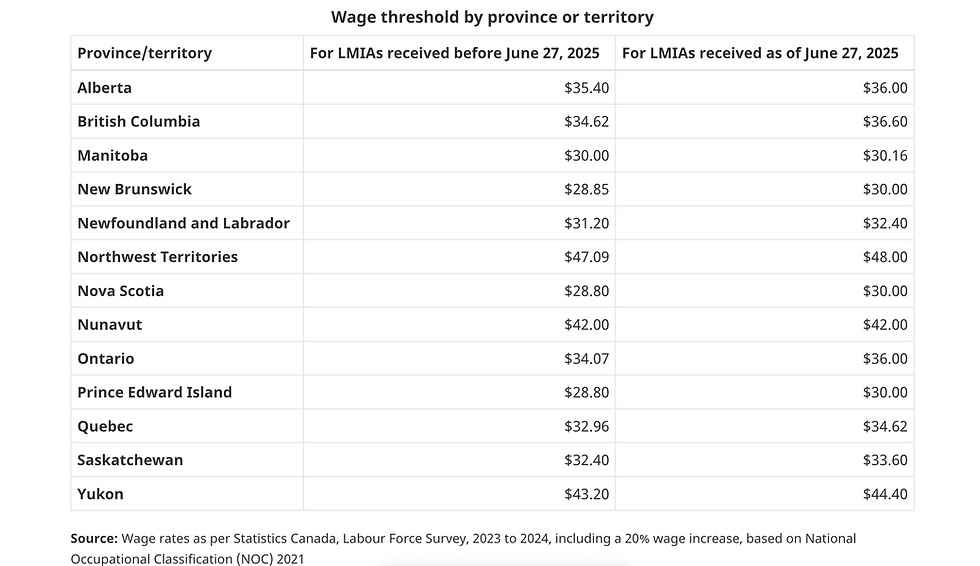Raising the Bar: What the New Wage Threshold Means for Canada’s Temporary Foreign Worker Program
- Betsy Kane

- Jul 3
- 3 min read
Updated: Aug 11

As of June 27, 2025, the Canadian government has officially raised the median wage thresholds for the High-Wage Stream of the Temporary Foreign Worker Program (TFWP). This change, part of a broader effort to prioritize domestic hiring and ensure fair compensation, is already reshaping the landscape for employers and foreign workers alike.
What’s Changed?
Employers hiring through the High-Wage Stream must now offer wages that are at or above the updated provincial or territorial median wage. For example, in Ontario, the threshold has increased from $34.07 to $36.00 per hour.
Impacts on Employers
For businesses, especially in sectors like hospitality, construction, and manufacturing, the new wage requirements mean higher labor costs. Employers must now reassess their budgets and hiring strategies, potentially shifting focus toward automation, upskilling local talent, or reducing reliance on temporary foreign labor.
Impacts on Foreign Workers
While the change may limit the number of new TFW positions, it also ensures better pay and potentially improved working conditions for those who qualify. However, it may also reduce opportunities for lower-skilled foreign workers who previously met the wage criteria.
Regional Access to the Low-Wage Stream Tightens
Adding to the complexity, the upcoming July 11, 2025, unemployment rate update will play a pivotal role in determining which regions remain eligible for the Low-Wage Stream. Currently, a moratorium is in place for 24 Canadian cities where unemployment rates exceed 6%, including Toronto, Calgary, Vancouver, and Montréal.
Employers in affected regions will not be able to submit new low-wage LMIA applications, and existing foreign workers in these areas may be unable to renew their permits unless their positions qualify under the High-Wage Stream. This policy underscores the government’s intent to prioritize local hiring in regions facing economic challenges.
Exceptions to the Refusal-to-Process Policy
Despite the restrictions, there are important exceptions. LMIA applications for low-wage positions in construction, healthcare, and food processing sectors are exempt from the refusal-to-process rule, even in regions where unemployment exceeds 6%.
A Balancing Act
This policy shift is part of a broader recalibration of Canada’s immigration and labor strategy, aiming to balance economic needs with social sustainability. With over 183,000 TFW permits issued in 2023 alone, the government is clearly signaling a move toward more selective access to Canada’s Temporary Foreign Worker Program (TFWP).
What does means is that for employers that need to access long-term Labour Market Impact Assessments? To qualify for a LMIA for a duration of at least three years, employers must advertise and offer wages at or above the median wage threshold established for the province and ensure that wages meet the median wage for the occupation in the location of work.
Below is the new median wage threshold chart as of June 27, 2025.

If your organization would benefit from clarification on how these changes may impact your workforce, please contact us to schedule a consultation.
This adjustment reflects a 5.66% increase, aligning with the government's goal to encourage the hiring of Canadian workers first.
This ban, in effect since April 4, 2025, is set to expire on July 10. On July 11, new unemployment data will be released, and cities may be added or removed from the restricted list based on whether their unemployment rates fall above or below the 6% threshold.
These sectors are considered essential to Canada’s economic and social infrastructure, and the government recognizes the ongoing labor shortages in these areas. Employers in these industries can continue to access the Low-Wage Stream, provided they meet all other program requirements.


Comments